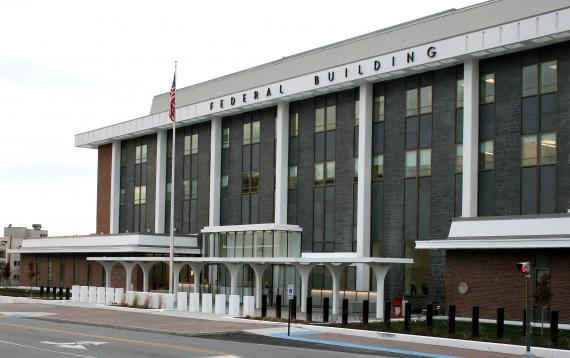
Women of Justice
This is part one of a four part series celebrating Women's History Month
Post filed in: Buildings
Did you know that out of more than 165 named U.S. Courthouses across the country, there are only four that bear the name of a woman? In honor of Women’s History Month, take a moment to learn more about these women and the buildings that have been named for them.

Margaret Chase Smith Federal Building and U.S. Courthouse
Bangor, ME

Margaret Chase Smith was born in Skowhegan, Maine on December 14, 1897. She became Maine’s first female member of Congress after winning a special election in 1940.
As a member of the Armed Services Committee, Chase Smith passed her landmark legislative achievement in the House: the Women’s Armed Forces Integration Act. With a wartime peak enrollment of about 350,000, women were still considered volunteers for the armed services and did not receive any benefits. President Harry S. Truman signed the bill into law on June 12, 1948.
In 1948, Chase Smith won election to the U.S. Senate, defeating her opponent with 71 percent of the vote. Chase Smith’s election marked the first time a woman won election to the Senate without the widow or appointment connection and the first time a woman served in both chambers. She was re-elected to the Senate three more times by comfortable majorities.
Chase Smith’s defining moment in the U.S. Senate came on June 1, 1950, when she took the Senate Floor to denounce the investigatory tactics of Wisconsin Senator Joseph McCarthy. In a speech she later called a “Declaration of Conscience”, she charged that her Republican colleague had “debased” Senate deliberations “through the selfish political exploitation of fear, bigotry, ignorance and intolerance”.
Senator Margaret Chase Smith announced her run for President in January 1964. At the 1964 Republican Convention, she became the first woman to have her name put in for nomination for the presidency by a major political party. Receiving the support of just 27 delegates, it was a symbolic achievement.

After losing the 1972 Senatorial election, Chase Smith resettled in her hometown of Skowhegan to oversee the construction of the Margaret Chase Smith Library Center, the first of its kind to focus its collection on the papers of a female Member of Congress. In 1989 President George H. W. Bush awarded her the Presidential Medal of Freedom, the nation’s highest civilian honor. She died in 1995.
The Federal Building and Courthouse, located near the Kenduskeag Stream in Bangor, Maine, was constructed in 1968. It is considered to be an important example of regional mid-century architecture. It was renamed the Margaret Chase Smith Federal Building and United States Courthouse in 1984. In 2015, a five-year renovation of the courthouse concluded. It included canopy and facade restoration, incorporation of a single security checkpoint and construction of a new entry pavilion using space originally configured as separate court and post office entries. Following the renovation, the building won an American Institute of Architects Chicago 2018 Design Excellence Award.
Firsts for Senator Chase Smith:
- First woman to serve in both houses of Congress
- First woman to represent Maine in both the U.S. House of Representatives and the U.S. Senate
- First woman to win election to the U.S. Senate without the widow or appointment connection
- First woman to have her name be placed in nomination for the presidency at a major political party’s convention
- First woman to serve as chair of the Senate Republican Conference
- First and only civilian woman to sail on a U.S. Navy ship during World War II
Footnote: There are only four buildings in GSA’s portfolio of owned properties that have a woman’s name and the word “Courthouse” in the official name of the building. While the other properties may currently house court activities, they are not officially “courthouses” in name.\
Women of Justice series:
- Women of Justice: Margaret Chase Smith
- Women of Justice: Sandra Day O’Connor
- Women of Justice: Judith N. Keep
- Women of Justice: Diana E. Murphy

 U.S. General Services Administration
U.S. General Services Administration
